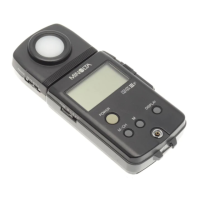
Do you have a question about the Minolta COLOR METER IIIF - PART 1 and is the answer not in the manual?
| Brand | Minolta |
|---|---|
| Model | COLOR METER IIIF - PART 1 |
| Category | Measuring Instruments |
| Language | English |
Details compliance with Part 15 of FCC Rules for potential interference.
Confirms digital apparatus does not exceed Class B limits for radio noise.
The light-sensitive part of the meter.
The display screen showing measurement results and settings.
Used to switch the meter's power on and off.
Selects memory channels for storing correction values.
Allows changing data stored in memory channels.
Port for connecting a flash sync cord.
Initiates light measurements.
Selects between ambient, sync cord, or non-sync cord modes.
Adjusts settings like shutter speed and memory channels.
Cycles through different display modes.
Selects measuring range for flash measurements (Lo/Hi).
Sets the meter for specific film types (Daylight, Tungsten A/B).
Reference tables for filter numbers.
Cover for accessing the battery compartment.
Icons indicating the current display mode (LB/CC, Filter/CC, Color Temp).
Icons indicating the selected measuring mode (AMBI, CORD, NON.C).
Shows shutter speed for flash measurements or analyze function.
Displays the primary measurement results or stored correction data.
Indicates the currently active memory channel (0-9).
Symbols indicating measurements outside the meter's range.
Indicates the selected flash measuring range (Lo or Hi).
Indicates when the light level exceeds the meter's measuring capability.
Indicates when the light level is below the meter's measuring capability.
Specifies the limits for displaying color temperature, LB, and CC values.
Specifies the limits for displaying Kodak Wratten filter numbers.
Details on powering the meter using AA batteries.
Instructions for activating and deactivating the meter.
Automatic shutdown to conserve battery life.
Alerts the user when batteries are low.
Shows required light-balancing and color-compensating filter values.
Shows Kodak Wratten filter numbers and CC index values.
Displays the light source's color temperature in Kelvins.
Tips to prevent object reflectance from affecting readings.
Describes the 90°/180° rotation capability of the receptor head.
Guidance on optimal meter placement relative to light source and subject.
Method for filtering when using multiple light sources.
Techniques for measuring and averaging identical light sources.
Approach for measuring and compensating dissimilar light sources.
How to fine-tune readings using stored memory values.
Procedure for measuring ambient light levels.
Selecting the appropriate range (Lo/Hi) for flash aperture.
Setting shutter speed, ensuring it's within camera's X-sync range.
Connecting the sync cord to the meter and flash.
Aiming the meter at the flash and pressing the button to measure.
Adjusting flash-range switch for out-of-range readings.
Procedure to subtract ambient light for flash-only measurements.
Selecting the appropriate range (Lo/Hi) for flash aperture without sync cord.
Setting shutter speed for non-cord flash measurements.
Meter waits for flash trigger after pressing measure button.
Aiming at flash and firing to take measurement.
Adjusting flash-range switch for out-of-range readings in non-cord mode.
Procedure to subtract ambient light for flash-only readings in non-cord mode.
Using flash measurement procedures with 'F' shutter speed setting.
The 'F' setting corresponds to an effective shutter speed of 1/15 sec.
Steps to choose one of the nine available memory channels.
Choosing whether to adjust LB or CC values in the selected channel.
Using up/down controls to input correction values.
Methodology for finding optimal correction values via test shots.
Repeating steps to set the remaining correction value (LB or CC).
Suggestion to use the holder for recording channel settings.
Importance of using consistent film batches and processing labs.
Recommendations for calibrating the viewing environment.
Adjusting meter readings for preferred color balance using memory channels.
Filters used to adjust color temperature, measured in mired shifts.
Filters used to adjust green/magenta balance, specified by nominal density.
Table relating LB index readings to specific Kodak Wratten filter numbers.
Explains CC filter effects and specifications (e.g., CC05G).
Compares the use and impact of filters placed at light source versus camera lens.
How to adjust exposure when using filters, especially lens filters.
Based on the ratio of blue to red light intensity in the spectrum.
Accuracy issues with light sources having non-continuous spectra.
Clarifies the difference between photographic and physics definitions.
Identifies light sources that may cause measurement issues.
Recommended approach for accurate results with problematic light sources.
Advice on temperature, shock, sunlight, and chemical exposure.
Instructions for cleaning the meter body and avoiding lubrication.
Prohibits user disassembly; recommends authorized service.
Warnings against disassembly, heat, leaks, and incorrect insertion.
Recommendations for storage and mixing of batteries.
Details on the meter's type, design, and photocell configuration.
Specifies film balance options (Daylight, Tungsten A/B).
Lists available modes (AMBI, CORD, NON.C) and measuring ranges.
Details on display options and their respective value ranges.
Describes analyze mode capabilities and memory channel functions.
Measures the consistency and precision of the meter's readings.
Specifies power requirements and physical dimensions.
Details on the meter's weight and included accessories.